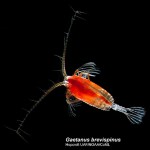new discoveries
The Census of Marine Life has just released a study of the ocean creatures living in the Arctic and the Antarctic with a startling revelation: 235 identical species thrive in the waters around the North and South Poles, despite the distance 11,000 kilometers between them.
The nemertean pelogonemertes rollestoni and its oddly shaped see-through stomach
While some of the animals migrate to the different areas from warmer seas (whales, birds, etc.) there are some creatures that are too small to migrate and thus are evidently identical species who are born and die in their separate poles.…
First ever footage of the Hispaniolan solenodon has emerged from a conversation group working in the Dominican Republic. The Hispaniolan solenodon was thought to be extinct due to habitat loss, but this video proves otherwise. The shrew-like creature is nocturnal and is believed to eat insects. Like certain shrews and the duck-billed platypus, it can administer poison, in this case via specialized teeth. The solenodon is believed to be the last living species in an evolutionary line of mammals that dates back 65 million years.
National Geographic has a more exclusive video on their website…
Subterranean...blind...predatory...smokin' hot AILF! These are all adjectives that you could use to describe a newly discovered ant from the Amazon rainforest. Dubbed the Martialis heureka or "Ant from Mars" (not kidding), the sightless creature lives inside the soil and presumably hunts prey with massive mandibles. The Ant from Mars also represents a new subfamily of ant, a discovery that hasn't happened since 1923 (Note: see comments for various competing view points).
Take me to your watermelon.
After evaluating the DNA of the ant, researchers have concluded that this ant is on the bottom…
Discovery.com recently reported two instances of animals manipulating sound to master their environments.
Cuckoos are known for tricking birds into rearing their chicks: They lay their eggs in another species' nest and, once hatched, the baby cuckoos push out the eggs and/or chicks of the host birds. While it's also known that the baby cuckoos can mimic the cries of the host birds' chicks, scientists were surprised to find that one Australian species, the Horsfield's bronze-cuckoo, takes this a step further.
Tengo pince hambre! Je suis baiser affamé! Sono scopare affamato! Excuse me, can…
Brits of all shapes and sizes have been spitting out mouth fulls of tea and shepherd's pie at the announcement that a strange unidentified insect seems to be running rampant across England, including London.
The black and red bug resembles the Arocatus roeselii, a rare central European insect, only Britain's bugs are significantly duller in color. It's not every day that an unknown species emerges in the center of one of the oldest cities in the world.
Click here to watch an informative video on the topic.
London's Natural History Museum will be analyzing specimens of the bug to determine…
A fascinating article in Livescience reveals the answer to a century-old zoological mystery: what do y-larvae grow up to become? Discovered in 1899, y-larvae are clearly young crustaceans but their adult stage could not be determined. While this in itself was perplexing, the newly discovered answer is even more startling: y-larvae metamorphosize into "simple, pulsing, slug-like masses of cells... far simpler than their larval stage." In a sense, the creatures revert backwards to forms more commonly seen further down the evolutionary ladder as they mature.
Watch the process
This awesome video…
A study of rare African frogs has revealed a form of self-defense hitherto unbeknownst to the scientific world: claws of pure bone that burst through the frogs' skin. And it gets worse. When the frogs are threatened they need to first "actively break" their own bones in order to create these claws.
Don't make me angry...you wouldn't like me when I'm angry.
David Blackburn of Harvard's Museum of Comparative Zoology released his team's findings last week in Biology Letters on the Trichobatrachus robustus, and ten other related species of frog, most of which live in Cameroon.
The frogs'…
The Arizona State University's Institute for Species Exploration has released their much anticipated picks for the top ten best new species discovered in the last year. From a rhinosaurus beetle that looks like a Pixar character to a fruit bat the fills in some evolutionary holes, this list supposedly has it all.
O Magazine called hot pink centipedes the MUST HAVE accessory for the summer.
Taking a cue from the Brother's Bleiman, the ASU Top Ten List sometimes attempts to combine humor with science...By clicking on the link below, you will see that it fails.
Click here to view the top ten…
Deep in the heart of the jungles of Borneo a new frog has been found that is rocking the very foundations of frog biology the world over. Why? Because, for God's sake, it has no lungs. Instead, it gets all the oxygen it needs by absorbing it through its skin.
Can you do me a favor real quick and blow cigarette smoke on me.
The frog- Barbourula kalimantanensis -was actually discovered 30 years ago, but only one known specimen had been collected, and no one thought to dissect it. The speedy, little, two inch-long, creatures proved...
...very difficult to find and catch. With a team of eleven…
Check out this footage from a recent international expedition called the Collaborative East Antarctic Marine Census. Their mission is part of an effort to take stock of all the life in the world's ocean, but these creatures were filmed in the Antarctic Ocean (Southern Ocean). The bulbous, plantlike structures are called tunicates.
Any snail enthusiast knows that their favorite creatures' shells follow certain stead-fast rules: They are cone shaped, right handed, and spiral on a single axis logarithmically. Well, let me just tell you what a shock it was to the snail community when scientists recently discovered the Opisthostoma vermiculum in Malaysia. The snail version of James Dean, the Opisthostoma vermiculum's shell breaks all the rules and answers to no one. Do you think you're the boss of it? You're not.
What a Hell's Angel's shell would look like if he wore one...
Seen in the picture above the Opisthostoma…
What? What? Huh? I can't hear you? What did you say? What?
A scientific expedition in the Gobi desert has yielded the holy grail for hamster lovers, film of the long-eared jerboa, a creature that has heretofore never been captured by a camera. Dr. Jonathan Baillie of the Zoological Society of London (ZSL) tracked down the big eared desert friends, filmed them and even captured them in "pitfall traps" so that he could study them more closely. Dr. Baillie's research has discovered that these nocturnal creatures spend their days in burrows and eat insects. Wow! Didn't see that coming!
Watch…
A voyage sponsored by the Census of Marine Life (CoML) has netted some newly discovered species in the depths of the Atlantic Ocean. The trawling net was pulled at the level between 1000 meters and 5000 meters deep. About 500 species were cataloged out of thousands caught. Most of the creatures were of the gelatinous sort, specially adapted to live in frigid waters deep in the depths. The scientists, trying to be nice, immediately plunged the creatures into icy water upon hoisting them into the boat, but of course, many of them did not survive the trip to the surface.
A tiny winged snail,…
Turns out that honey bees might not have the ideal socialist society after all. Researchers at Otago University in New Zealand have discovered that worker bees behave like drones because of a powerful, brainwashing pheromone released by the queen. The queen bee prevents aggressive behavior in the workers by releasing homovanillyl alcohol or HVA. As described by the New Zealand Herald, the HVA, released from the queen's mandibles, "blocks aversive learning, the acquisition of negative memories which would normally trigger an aggressive 'sting reflex' in the bees." Bees who don't learn to sting…
Scientists at Holar University College and the University of Iceland have identified two species of amphipods which have likely survived since well before the last ice age. Quoted in an article in Nature-Science, Bjarni K. Kristjansson, the scientist who made the discovery, says, "These finding can only be explained by these animals surviving glaciations in some kind of refugium under the glaciers." The finding is significant because scientists had believed that ice ages wipe out all animals on land and freshwater in large portions of the Northern Hemisphere.
Why wasn't this adorable little…
In the frigid waters off the coast of Norway lives a massive coral reef. With a footprint of over 40 kilometers across, the Rost Reef was discovered by echo sound equipment in 2002. Though the water at the bottom is only 2 degrees Centigrade above freezing, the reef is host to abundant life from plankton to fish.
Recently, researchers from the University of Plymouth in the United Kingdom explored the reef with a submersible for the first time. Their footage shows just how lively those friggin freezing waters can be...
(Note: Actual underwater footage starts at 3:15 in the film. We suggest you…

